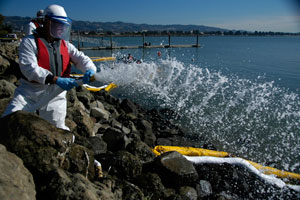On Monday, the EPA announced the results of a second round of tests on dispersant, results that they believe justify the use of the chemicals on the Gulf spill. The oil-dispersant mixture was no more toxic than the oil alone, the agency said, and BP’s product of choice, Corexit, was just about as toxic as alternatives. But that doesn’t mean the debate about the chemicals is over, or that the impact of dumping more than 1.8 million gallons of dispersant on the Gulf will be clear any time soon. Senators, the EPA point person, and outside experts sparred on the subject at an Environment and Public Works committee hearing on Wednesday.
Sen. Sheldon Whitehouse (D-RI) grilled Paul Anastas, the assistant administrator for the EPA’s Office of Research and Development, about how products end up on the list of approved chemicals for spills. The exchange forced Anastas to admit that the EPA only “lists” chemical dispersants based on their efficacy at dispersing oil. The products are only required to effectively disperse 45 percent of the oil. Other tests, like the toxicity of the product, have no bearing on whether they are listed. “It could be as toxic as all get-out, and it still goes on the list as long as it meets the 45 percent effectiveness threshold,” Whitehouse said.
Anastas confirmed that companies are supposed to submit toxicity data “as part of the filing,” but the EPA does not actually look at toxicity when “listing” these chemicals.
In a later exchange with David Westerholm, director of the office of response and restoration at the National Oceanic and Atmospheric Administration, Whitehouse pointed out that the there’s a perception that the dispersants are actually “approved” rather than just listed:
What a layperson would consider to be an approval that this particular chemical is safe for use in these circumstances, never anywhere in this process that I can see actually gets done … But what a regular human would think of as something having been approved never actually happened. Nobody actually ever looked at that and said, ‘You know what? That is too toxic to use in these circumstance or is more or less toxic than the other.’ And that’s why after the fact you had to do the relative toxicity testing after they’d all been preapproved, correct?
“I think that that’s a great point,” Westerholm replied.
“I can’t think of another circumstance in which a regulatory agency approved something for use without actually coming to a formal decision that it is safe to be used and without any process other than that the manufacturer provides some information, then it’s posted and then—there didn’t appear to be an evaluating moment,” Whitehouse continued.
Meanwhile, outside experts painted a much less rosy picture of the dispersant issue than the EPA offered earlier this week. “My colleagues and I that have been studying this situation believe that a massive eco-toxicological experiment is under way,” Ronald Kendall, director of Texas Tech University’s Institute of Environmental and Human Health told the panel. “We have very limited information on the environmental fate and transport of the mixture of the dispersant and oil, particularly in the deep ocean.”
Other experts noted that dispersed oil isn’t necessarily any less of an environmental threat—despite what yeterday’s government report may have implied. At least half of the oil is still in the Gulf, even if it’s not visible.
“Moving oil below the sea surface presents significant challenges to the organisms residing in this habitat,” David Smith, professor of oceanography at the University of Rhode Island, told the Senate panel. “Impacts will be less noticeable, but could be as devastating as oil washing ashore.”
So, despite yesterday’s sunny picture from the government, there’s still a lot we don’t know about the impacts of the dispersant and the dispersed oil—and a lot that EPA and NOAA don’t know, either.










